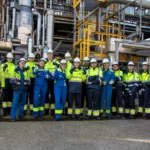Founder of Rethink Global, Catherine Weetman calls for systemic changes to create value instead of waste

Moving to a regenerative, circular economy is the key to a low-carbon economy and offers opportunities for the chemical industry to develop profitable products and services.
That’s the view of Catherine Weetman,founder of Rethink Global, author of A Circular Economy Handbook and host of the Circular Economy Podcast.
“The business landscape has changed forever,” Weetman says in an interview. “We’re no longer a small population on a seemingly limitless planet with endless new horizons. Now we’re a massive population on a fragile planet with finite and depleted resources and people everywhere under pressure.”
The 2023 World Economic Forum Risks Survey sees environmental and societal crises dominating the next decade, driven by underlying geopolitical and economic trends, while highlighting the perils of “biodiversity loss and ecosystem collapse.” Of the top 10 risks over the next decade, six are major environmental risks, according to the survey.
Weetman describes the current system as a “waste economy.” “Over the past few decades, most businesses have focused on growing revenue: selling more through planned obsolescence, disposability, and encouraging people to accumulate ever more stuff. We’re using up finite resources at a frightening rate whilst wasting and destroying value at every stage in the process.”
Weetman helps businesses develop circular and regenerative strategies that are better for people and the planet and deliver healthy profits. Disruptors are already capitalising on opportunities to “close the loop” on wasted value, and she believes success is at the sweet spot where sustainability and stakeholder value come together.
Moreover, Weetman sees the waste economy as a root cause of the ecological and social crises. A 2019 Global Resources Outlook by the United Nations Environment Programme notes that resource extraction and processing cause over 90% of global biodiversity loss and water stress, and more than half of global climate change impacts. “What’s more, the many impacts of pollution on human health are becoming ever clearer. Addressing these root causes is critical. We’ve run out of time for incremental improvements or false solutions that promise to solve one problem whilst creating others. We’ve got to make systemic changes.”
‘Innovators Dilemma’ facing businesses
Weetman recalls the Innovators Dilemma in which Clayton Christensen described two kinds of innovation: “sustaining innovation,” focusing on incremental improvements, and “disruptive innovation,” creating new markets and value systems that eventually make market-leading products – and even companies – obsolete. Big companies may especially see the disruptive potential, while worrying about cannibalising their existing offers.
Weetman sees Kodak as a prime example. It invented the digital camera to capitalise on digitalisation, while continuing to profit from its core business of film processing and printing. It focused on developing ways to link digital and photo printing, but crucially failed to understand that customers just wanted easy ways to take pictures and share their stories. The advent of digital photos and social media made printed photos appear expensive, slow and inconvenient.
In less than a decade, Kodak crashed from market leader to bankruptcy protection (though it later emerged from bankruptcy). Weetman notes that over the same period, Fuji (Kodak’s nearest competitor) pivoted, leveraging its film chemicals expertise to diversify and growing its revenue by over 50%.
To avoid the risk of failure, Weetman recommends that every organisation identifies their own ‘blind spots’ and explores systemic risks and disruptive opportunities. “This isn’t a quick fix,” she says. “To survive – and thrive – means companies putting circular and regenerative strategies at the heart of their business.”
Weetman highlights examples of big company circular initiatives, such as Caterpillar, JCB and Cummins with highly profitable remanufacturing divisions; eBay enabling the growing market in second-hand items; Dell India turning smog from diesel engines into ink for packaging; and Nestlé recovering and reusing its plastic waste in the Philippines. She says: “Businesses must ask: ‘How can I keep this customer for life? Where are we leaking or destroying value, and how do we turn that into circular opportunities?’”
Yet at a global level, the trend is still in the wrong direction. Global circularity decreased from 9.1% in 2018 to 8.6% in 2020 to 7.2% in 2023, according to The Circularity Gap Report 2023, published by the Circle Economy organisation. These percentages refer to materials that are cycled back into the global economy at their end of useful life. A circular economy could reverse this trend by reducing global material extraction and use by a third, according to Circle Economy. It notes that currently, our economy relies almost exclusively on new materials, which means that more than 90% of materials are wasted, lost or unavailable for reuse.
“A global circular economy will allow us to fulfil people’s needs with only 70% of the materials we now extract and use—moving human activity back within the safe limits of the planet,” notes the 2023 report.
Keeping molecules in the loop
Circle Economy calls for us to use less, use longer, use again and make clean (prepare for reuse). Weetman agrees, emphasising the need for safe, non-toxic, sustainable materials and noting the opportunities for by-products when eliminating waste in production processes.
Ease of repair, remanufacturing and disassembly are key design features for circularity. Weetman highlights the work of Walter Stahel, one of the original circular economy thinkers. In his latest book, Stahel outlines “the era of D” – de-bonding, de-lamination, de-polymerisation, de-alloying, de-vulcanising, de-coating and deconstructing.
“There are so many ways the chemical industry can benefit by enabling those processes,” Weetman notes, highlighting innovations in self-repairing materials. Start-ups, such as Nth Cycle, use electro-extraction to recover critical metals and the University of Leeds (UK) is developing a sewing thread that dissolves when subjected to low-level microwaves to make the disassembly of clothing easier. “These kinds of innovations can be absolute game-changers,” Weetman says.
Research has highlighted the potential for “leasing” chemicals instead of selling them as a way to extend their use. Take a solvent, for example: a chemical provider could apply it to a company’s manufacturing process, then recapture and clean it for use by another company. This idea links to Stahel’s concept of renting molecules, such as metals.
Improving the safety and sustainability of materials is critical. Weetman says companies should be more transparent about lifecycle assessments and go further than carbon, improving biodiversity and other environmental outcomes. Material “passports” help, enabling companies to know exactly what’s in products. For example, Bluesign of Switzerland, in partnership with Patagonia, offers sustainable textile certification, evaluating and reducing resource consumption in its material supply chain as well as approving chemicals, materials, processes and products that are safe for the environment, workers and end users. “Any company putting a product into marketplace should take responsibility for it, and we are starting to see extended producer responsibility legislation to support that,” Weetman states.
She suggests the chemical industry could develop customised guides for the circular economy, to help designers make better choices to support the “Era of D.” Collaborating across the industry could help screen out toxic chemicals and materials; ensure safe production practices as well as fair labour and trade; implement recycling systems; and harmonise international standards in each of these areas. Weetman encourages the industry to work with local governments and competitors to push for circularity.
Recycling only part of the solution
Minimising waste in the first place creates much more value than recycling it, Weetman contends. “Recycling is not the panacea.” Instead, she emphasises the importance of reducing the global flow of materials, by using less, making things that last longer, providing services that help people use them more efficiently and effectively, then recovering them to be used again.
“Whatever we’re putting in place has got to have a lower footprint,” Weetman says. “We must avoid recycling processes that solve one problem, but create a whole load of others.” Crops grown exclusively for bioplastics, for example, may add to the pressures on land and in water and ecosystems.
Disruptors are proving that circular and regenerative solutions are profitable, plugging the value gaps in existing systems. For example, Circular Computing says its carbon-neutral remanufactured HP, Dell and Lenovo laptops deliver up to 40% cost savings compared to brand new models, as well as significant sustainability benefits. Recycling products that could have been reused, repaired or remanufactured means value is lost for the customer, company, and all of its stakeholders. If those products are discarded, even more value is lost.
Europe can move faster to a circular economy, while maintaining its competitiveness by encouraging the right kind of innovation, Weetman adds, through policies, such as eco-design standards and “right to repair” legislation.
“Longer lasting, repairable, shareable products can create multiple cycles of value,” Weetman says. “Assuming endless supplies of finite materials is risky. Different sectors are all banking on affordable access to key resources and failing to see the potential for geo-political and economic conflict. We’re reaching critical tipping points, and this needs systemic change – we have to reimagine the ways we make and use things.”
“It’s not a zero-sum game,” Weetman concludes. “We can survive and thrive by working with our customers, suppliers and competitors to create circular and regenerative value. Either we all work together or we all lose.”











